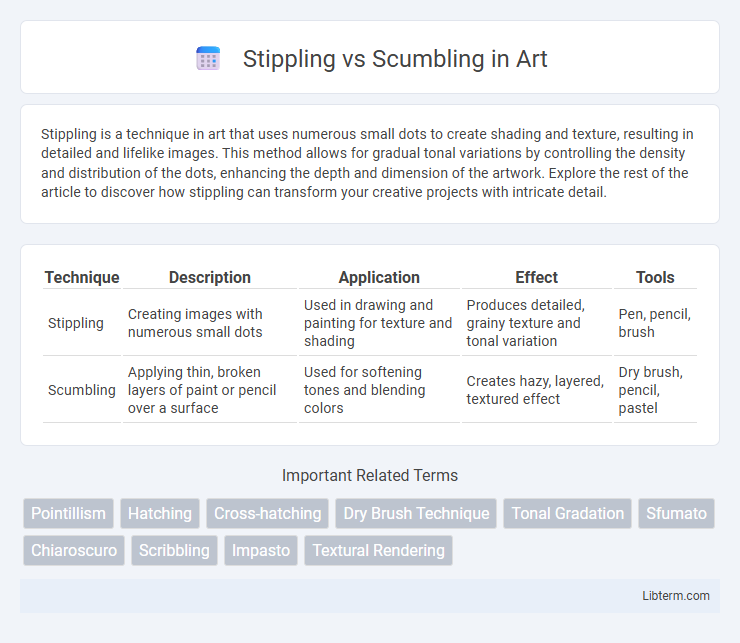Stippling is a technique in art that uses numerous small dots to create shading and texture, resulting in detailed and lifelike images. This method allows for gradual tonal variations by controlling the density and distribution of the dots, enhancing the depth and dimension of the artwork. Explore the rest of the article to discover how stippling can transform your creative projects with intricate detail.
Table of Comparison
| Technique | Description | Application | Effect | Tools |
|---|---|---|---|---|
| Stippling | Creating images with numerous small dots | Used in drawing and painting for texture and shading | Produces detailed, grainy texture and tonal variation | Pen, pencil, brush |
| Scumbling | Applying thin, broken layers of paint or pencil over a surface | Used for softening tones and blending colors | Creates hazy, layered, textured effect | Dry brush, pencil, pastel |
Understanding Stippling and Scumbling
Stippling and scumbling are two fundamental drawing techniques used to create texture and depth through different mark-making methods. Stippling involves applying numerous small dots or points to build up shading and contours, allowing for precise control over tonal variation and smooth gradation. Scumbling, by contrast, uses a series of small, overlapping circular or scribbled strokes to produce a softer, more textured effect, ideal for conveying rough or uneven surfaces.
Historical Background of Each Technique
Stippling, with roots tracing back to ancient cave paintings and Renaissance engraving, became prominent in printmaking and pen-and-ink drawings as artists sought to create tonal variation through dots. Scumbling emerged during the Renaissance as a painting technique used by Old Masters like Leonardo da Vinci and Rembrandt to achieve texture and subtle gradations by applying thin, broken layers of paint. Both methods developed historically to enhance depth and dimension in artworks, reflecting the evolving understanding of light and texture in visual representation.
Core Principles of Stippling
Stippling relies on creating texture and shading through numerous small dots, where the density and distribution of the dots control the value and depth of the artwork. The core principle centers on varying dot concentration to achieve gradients and detailed tonal effects without using lines or brushstrokes. This technique demands patience and precision, making it ideal for producing intricate and highly controlled images.
Core Principles of Scumbling
Scumbling involves layering broken, semi-transparent strokes to create texture and subtle color transitions, emphasizing lightness and softness in the artwork. Unlike stippling, which uses distinct dots to build form and value, scumbling relies on loose, circular motions to blend colors visually without fully mixing them on the palette. Core principles of scumbling include controlling brush pressure, maintaining varied directionality, and applying successive thin layers to achieve depth and atmospheric effects.
Materials and Tools Needed
Stippling requires fine-tipped pens, brushes, or pencil points that allow for precise dot application, often using ink, graphite, or acrylic paints on smooth paper or canvas to achieve controlled texture. Scumbling involves using softer brushes or dry media like charcoal or pastel applied with a scrubbing motion, typically on textured surfaces such as rough paper or primed canvas to create layered, broken color effects. Artists may also use blending stumps or sponges in scumbling to enhance the visual depth and softness absent in stippling's crisp, pointillist approach.
Step-by-Step Stippling Process
Stippling involves creating texture and shading through numerous small dots applied systematically with varying density to achieve depth and dimension. Begin with a light outline of the subject, then gradually build up tonal values by placing dots closer together in shadowed areas and sparsely in lighter zones, maintaining consistent pressure for uniformity. The layering process requires patience and precision, as each dot contributes to the overall gradient and detail, distinguishing stippling from scumbling, which uses loose, scribbled strokes instead of defined points.
Step-by-Step Scumbling Process
Scumbling involves a layered technique using small, circular, and overlapping brush strokes to build texture and depth gradually. Begin by applying a thin, semi-dry layer of paint with a stiff brush, moving in loose, controlled motions to create a soft, broken effect. Repeat multiple layers, allowing each to dry slightly, to enhance tonal variation and achieve a rich, textured surface.
Visual Effects: Texture and Depth
Stippling creates visual effects through the use of small, distinct dots that build texture and depth by varying density and spacing, resulting in a granular, detailed surface. Scumbling employs loose, circular, or scribbled strokes to layer colors and tones, producing a softer, more blended texture that enhances atmospheric depth. Both techniques manipulate light and shadow differently, with stippling emphasizing contrast and fine detail, while scumbling offers a rich, textured gradient for dimensionality.
When to Use Stippling vs Scumbling
Stippling is ideal for creating detailed textures and fine gradients by applying numerous small dots, making it perfect for realistic shading in pen and ink drawings. Scumbling, characterized by loose, scribbled strokes, is best used to add tonal variations and a sense of movement or softness in pastel or charcoal artwork. Choose stippling when control and precision are needed, while scumbling is preferred for expressive, layered effects.
Tips for Mastering Both Techniques
Mastering stippling requires consistent practice in controlling dot density and spacing to create smooth gradients and texture, while scumbling demands loose, circular motions that build layers of soft, overlapping strokes for a rich, atmospheric effect. Utilize fine-tipped pens or brushes for precise stippling and experiment with varied pressure and brush angles during scumbling to achieve depth and tonal variation. Combine patience with observation of light and shadow to effectively balance both techniques in detailed artwork.
Stippling Infographic

 libterm.com
libterm.com